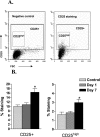Increased CD4+ CD25+ T regulatory cell activity in trauma patients depresses protective Th1 immunity
- PMID: 16998360
- PMCID: PMC1856576
- DOI: 10.1097/01.sla.0000239031.06906.1f
Increased CD4+ CD25+ T regulatory cell activity in trauma patients depresses protective Th1 immunity
Abstract
Objectives: We recently reported increased CD4 CD25 T regulatory (Treg) activity after burn injury in mice. This study sought to determine if Tregs mediate the reduction in TH1-type immunity after serious injury in man and if Treg function is altered by injury.
Methods: Peripheral blood was withdrawn from 19 consenting adult patients (35.1 +/- 16.3 years of age) with Injury Severity Scores (ISS) 36.6 +/- 13.9 on days 1 and 7 after trauma and from 5 healthy individuals. CD4 T cells were purified and sorted into Treg (CD25(high)) and Treg-depleted populations. After activation of cells with anti-CD3/CD28 antibody, production of the TH1-type cytokine IFNgamma, TH2-type cytokines (IL-4 and IL-5), and the inhibitory cytokine IL-10 was measured using cytometric bead arrays. Treg activity was measured by in vitro suppression of autologous CD4 T cell proliferation.
Results: All patients survived, 9 (47%) developed infection postinjury. IFNgamma production by patient CD4 T cells was decreased on day 1 and day 7, when compared with healthy controls. However, when Tregs were depleted from the CD4 T cells, the IFNgamma production increased to control levels. Tregs were the chief source of IL-4 and IL-5 as well as IL-10. Treg suppression of T cell proliferation increased significantly from day 1 to day 7 after injury.
Conclusions: We demonstrate for the first time that human Tregs are increased in potency after severe injury. Most significantly, Tregs are important mediators of the suppression of T cell activation and the reduction in TH1 cytokine production found after injury.
Figures




Similar articles
-
Depressed interleukin-12-producing activity by monocytes correlates with adverse clinical course and a shift toward Th2-type lymphocyte pattern in severely injured male trauma patients.Crit Care Med. 2003 Jun;31(6):1722-9. doi: 10.1097/01.CCM.0000063579.43470.AA. Crit Care Med. 2003. PMID: 12794411
-
Alloantigen specific T regulatory cells in transplant tolerance.Int Immunopharmacol. 2009 May;9(5):570-4. doi: 10.1016/j.intimp.2009.01.016. Epub 2009 Jan 29. Int Immunopharmacol. 2009. PMID: 19539571 Review.
-
Functional assay for human CD4+CD25+ Treg cells reveals an age-dependent loss of suppressive activity.J Neurosci Res. 2003 Oct 15;74(2):296-308. doi: 10.1002/jnr.10766. J Neurosci Res. 2003. PMID: 14515359
-
Expression of Foxp3+CD4+CD25+ regulatory T cells and Th1/Th2, Tc1/Tc2 profiles in the peripheral blood of patients with condyloma acuminatum.Clin Exp Dermatol. 2009 Mar;34(2):229-35. doi: 10.1111/j.1365-2230.2008.03001.x. Epub 2008 Dec 2. Clin Exp Dermatol. 2009. PMID: 19077104
-
The effects of injury on the adaptive immune response.Shock. 1999 Mar;11(3):153-9. doi: 10.1097/00024382-199903000-00001. Shock. 1999. PMID: 10188766 Review.
Cited by
-
Monitoring immune dysfunctions in the septic patient: a new skin for the old ceremony.Mol Med. 2008 Jan-Feb;14(1-2):64-78. doi: 10.2119/2007-00102.Monneret. Mol Med. 2008. PMID: 18026569 Free PMC article. Review.
-
Stored red blood cell transfusion induces regulatory T cells.J Am Coll Surg. 2009 Jan;208(1):110-9. doi: 10.1016/j.jamcollsurg.2008.08.012. Epub 2008 Oct 10. J Am Coll Surg. 2009. PMID: 19228512 Free PMC article.
-
Vulnerability imposed by diet and brain trauma for anxiety-like phenotype: implications for post-traumatic stress disorders.PLoS One. 2013;8(3):e57945. doi: 10.1371/journal.pone.0057945. Epub 2013 Mar 6. PLoS One. 2013. PMID: 23483949 Free PMC article.
-
Regulatory T Cells Modulate CD4 Proliferation after Severe Trauma via IL-10.J Clin Med. 2020 Apr 8;9(4):1052. doi: 10.3390/jcm9041052. J Clin Med. 2020. PMID: 32276346 Free PMC article.
-
Update on the immunological pathway of negative regulation in acute insults and sepsis.J Interferon Cytokine Res. 2012 Jul;32(7):288-98. doi: 10.1089/jir.2011.0117. Epub 2012 Apr 17. J Interferon Cytokine Res. 2012. PMID: 22509978 Free PMC article. Review.
References
-
- Moore FA, Sauaia A, Moore EE, et al. Postinjury multiple organ failure: a bimodal phenomenon. J Trauma. 1996;40:501–510; discussion 510–512. - PubMed
-
- Mannick JA. 15th Annual Semmelweis Lecture Surgical Infection Society-Europe: injury-induced immune dysfunction: is the lymphocyte irrelevant? Surg Infect (Larchmt). 2002;3:297–302. - PubMed
-
- Mannick JA, Rodrick ML, Lederer JA. The immunologic response to injury. J Am Coll Surg. 2001;193:237–244. - PubMed
-
- De AK, Kodys KM, Pellegrini J, et al. Induction of global anergy rather than inhibitory Th2 lymphokines mediates posttrauma T cell immunodepression. Clin Immunol. 2000;96:52–66. - PubMed
Publication types
MeSH terms
Substances
Grants and funding
LinkOut - more resources
Full Text Sources
Medical
Research Materials

